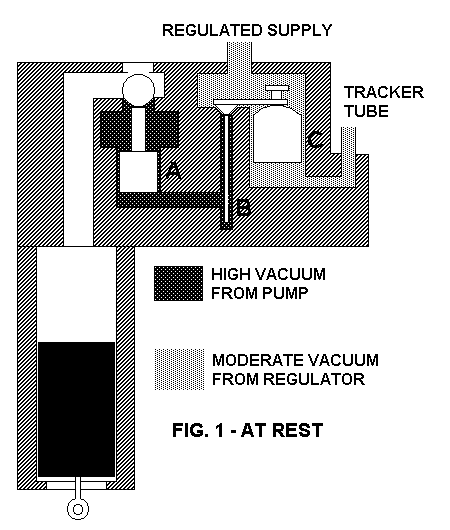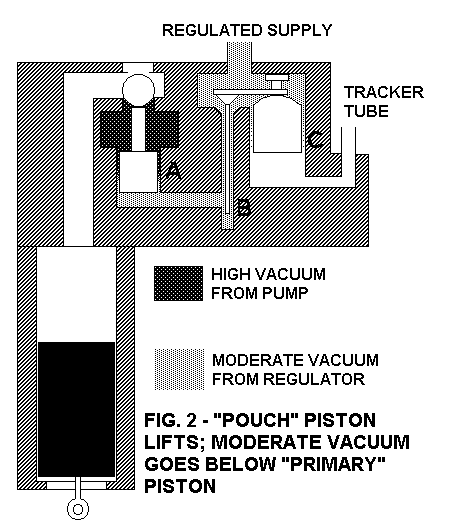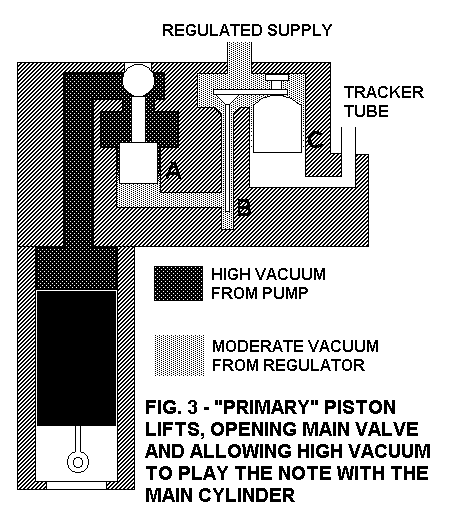Boyd Pistonola Theory
Boyd Pistonola Player Action
- Theory
by Richard Vance (MMD 000228)
| I agree with Craig Brougher that the Pistonola is a terribly unsatisfactory
design, but there is more to it than meets the eye. The printed description
quoted by Mr. Pritchett is flawed in some respects, which might be expected
in a general book about player pianos, rather than the Pistonola manual
itself.
First of all, the statement that the 'tension' is 25 times greater than
in an ordinary player must be in error. I calculated the force-area
ratios between the Pistonola and an ordinary player, not forgetting that
a pneumatic's force is area x pressure x 1/2 due to the hinged end, while
a piston' force is simply area x pressure. The result was a factor
of about 11, or 132 inches water column (inWC) in the Pistonola, equivalent
to 12 inWC in an ordinary player.
But the area of the feeder pistons is proportionally much smaller; if
the feeder pistons are 3" in diameter, the pedal force ends up nearly the
same as for a conventional feeder, about 35 pounds for the 12 inWC example. |
 |
Also, the chapter is not very clear about how the thing actually works.
It seems to me to be actually fluidically rather sophisticated. I
don't think there are any bleeds at all. There are two small pistons,
which I will call the 'pouch piston', connected to the tracker bar, and
the 'primary piston', which opens the main player valve.
The clue is the statement that these pistons are not graphite composition,
which would seal to their cylinders, but brass turnings. They are
machined just a bit smaller than the cylinders, and the small clearance
would form a relatively long laminar flow path of relatively small capacity,
serving the same purpose as a conventional bleed. There are two such
'bleeds', which seem to work as follows.
The space above the 'pouch piston' is fed with a much reduced vacuum
from the roll motor regulator. This prevents the very high main vacuum
from clamping the paper to the tracker bar. When no hole in the roll
is present, the leak around this piston (C) keeps the tracker tube evacuated.
If a hole appears, its capacity is much greater than the leak, and atmospheric
pressure lifts the 'pouch piston' and opens the cone valve. Thus
this leak serves the same purpose as the bleed in an ordinary player. |
 |
| The 'primary piston' also has a small clearance leak (A) which normally
keeps the main vacuum on both ends of this piston. But when the cone
valve lifts, the capacity around its stem (B) is much larger, so the pressure
under the 'primary piston' rises, not to atmospheric, but to the higher
regulated pressure. This differential pressure is sufficient to lift
the main ball valve and evacuate the note playing cylinder.
The flow through this second 'bleed' is not wasted; it just joins the
flow to the roll motor, causing the roll vacuum regulator to open just
a bit less.
This concept is shown more clearly on some schematic pictures I made.
Richard Vance
Mon, 28 Feb 2000 13:19:10 -0500 |
 |
29 February 2000
|
 Pictures
Pictures
 Pistonola
Pistonola
 pistonola_theory1
pistonola_theory1


